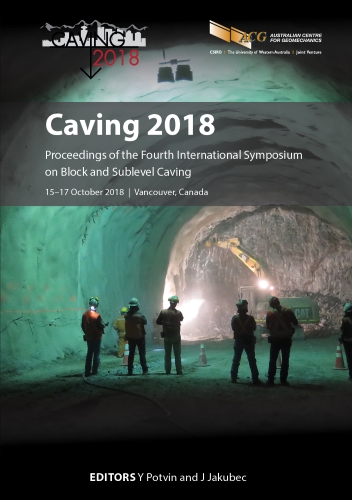Strategy for research and development in the cave mining industry

|
Authors: Ferguson, GA; Cuello, D; Gandara, P; Potvin, Y; Rojas, E |
DOI https://doi.org/10.36487/ACG_rep/1815_37_Ferguson
Cite As:
Ferguson, GA, Cuello, D, Gandara, P, Potvin, Y & Rojas, E 2018, 'Strategy for research and development in the cave mining industry', in Y Potvin & J Jakubec (eds), Caving 2018: Proceedings of the Fourth International Symposium on Block and Sublevel Caving, Australian Centre for Geomechanics, Perth, pp. 487-498, https://doi.org/10.36487/ACG_rep/1815_37_Ferguson
Abstract:
Some four decades ago, P Tregelles, Director of the Mining Research and Development, National Coal Board, Bretby, United Kingdom, outlined a strategy upon which research and development work could maximise its contribution to the safety and productivity of the coal mining industry in the United Kingdom. Such a strategy was founded upon the progress of projects through four phases: research, development, demonstration, and exploitation. Whilst it might be said that cave mining invariably provides safe and highly productive operations, it faces a number of considerable challenges in the areas of caving mechanics, rock mass blasting, ground support, measurement of in situ rock mass properties, modifying rock mass properties (preconditioning and destressing), and monitoring the response of the rock mass to the various phases of cave mining. In a similar fashion to the approach of Tregelles, this paper suggests the concept of establishing a global cave mining research and development framework co-ordinated within an informal network, upon which the global cave mining industry might adopt a consensus with respect to the research and development required over the next two to three decades, to maximise safety and thereby improve productivity. Commencing with a discussion and definition of present and future cave mining problems, a global strategy may be structured upon the mines best placed to study and develop solutions to specific mining problems, acting as development centres – where advances can be shared and exchanged.
Keywords: autonomous mining, cave mining variant, mudrush, numerical modelling, preconditioning, R&D
References:
Araneda, O & Sougarret, A 2008, ‘Lessons learned in cave mining at the El Teniente mine over the period1997-2007’, Proceedings of MassMin 2008, Luleå University of Technology, Luleå, pp. 43–52.
Cumming-Potvin, D 2018, An Extended Conceptual Model of Caving Mechanics, PhD thesis, The University of Western Australia.
Cumming-Potvin, D, Wesseloo, J, Jacobsz, SW & Kearsley, EP 2016a, ‘Fracture banding in caving mines’, The Journal of the Southern African Institute of Mining and Metallurgy, vol. 118, no. 8, pp. 753–761.
Cumming-Potvin, D, Wesseloo, J, Jacobsz, SW & Kearsley, E 2016b, ‘Results from physical models of block caving’, Proceedings of MassMin2016, The Australasian Institute of Mining and Metallurgy, Melbourne, pp. 329–340.
Cumming-Potvin, D & Wesseloo, J 2014, ‘Assessing the state of the rock mass in operating block caving mines: A review’, in R Castro (ed.), Proceedings of the Third International Symposium on Block and Sublevel Caving, Universidad de Chile, Santiago,
pp. 118–127.
Donigian, AS 2007, Watershed Model Calibration and Validation: Issues and Procedures, Aqua Terra Consultants, Mountain View.
Duplancic, P 2001, Characterisation of Caving Mechanisms Through Analysis of Stress and Seismicity, PhD thesis, The University of Western Australia.
Ferguson, GA 2015, Evolution of a Design Methodology for Use in Cave Mines Developed in Challenging Geomechanics Environments, unpublished PhD thesis, The University of Leeds, Leeds.
Landeros, P, Cuello, D & Rojas, E 2012, ‘Cave-back management at Reservas Norte Mine, Codelco Chile, El Teniente Division’, Proceedings of MassMin 2012, Canadian Institute of Mining, Metallurgy and Petroleum, Westmount.
Maxwell, SC, Rutledge, J, Jones, R & Fehler, M 2010, ‘Petroleum reservoir characterization using downhole microseismic monitoring’, Geophysics, vol. 75, no. 5, pp. 75A129–75A137.
Mendecki, AJ & Lötter, EC 2017, Elements of Seismic Hazard for El Teniente/NML Seismogenic Area, report, Institute of Mine Seismology, Hobart.
Pardo, C & Rojas, E 2016, ‘Selection of a mining method based on the experience of hydraulic fracture techniques at the El Teniente mine’, Proceedings of MassMin 2016, The Australasian Institute of Mining and Metallurgy, Melbourne, pp. 97–103.
Rojas, E, Cavieres, P, Dunlop, R & Gaete, S 2000, ‘Control of induced seismicity at El Teninte mine, Codelco-Chile’, in G Chitombo (ed.), Proceedings of MassMin 2000, The Australasian Institute of Mining and Metallurgy, Melbourne, pp. 775–781.
South African Mines Inspectorate 2011, Guideline for the Compilation of a Mandatory Code of Practice for the Design, Development/Construction, Safe Operation and Maintenance of Draw Points, Tipping Points, Rock Passes and Box Fronts, Department of Mineral Resources, Pretoria.
Tregelles, PG 1978, Strategy for Mining Research and Development in the United Kingdom (Coal Industry), presented at a Joint Meeting of The Institution of Mining Engineers and The Institution of Mining and Metallurgy held at the Europa Hotel, London, 27th January 1978.
Widijanto, E, Sunyoto, W, Wilson, AD, Yudanto, W & Soebari, L 2012, ‘Lessons learned in wet muck management in Ertsberg East Skarn System of PT Freeport Indonesia’, Proceedings of MassMin 2012, Canadian Institute of Mining, Metallurgy and Petroleum, Westmount.
© Copyright 2026, Australian Centre for Geomechanics (ACG), The University of Western Australia. All rights reserved.
View copyright/legal information
Please direct any queries or error reports to repository-acg@uwa.edu.au
View copyright/legal information
Please direct any queries or error reports to repository-acg@uwa.edu.au
